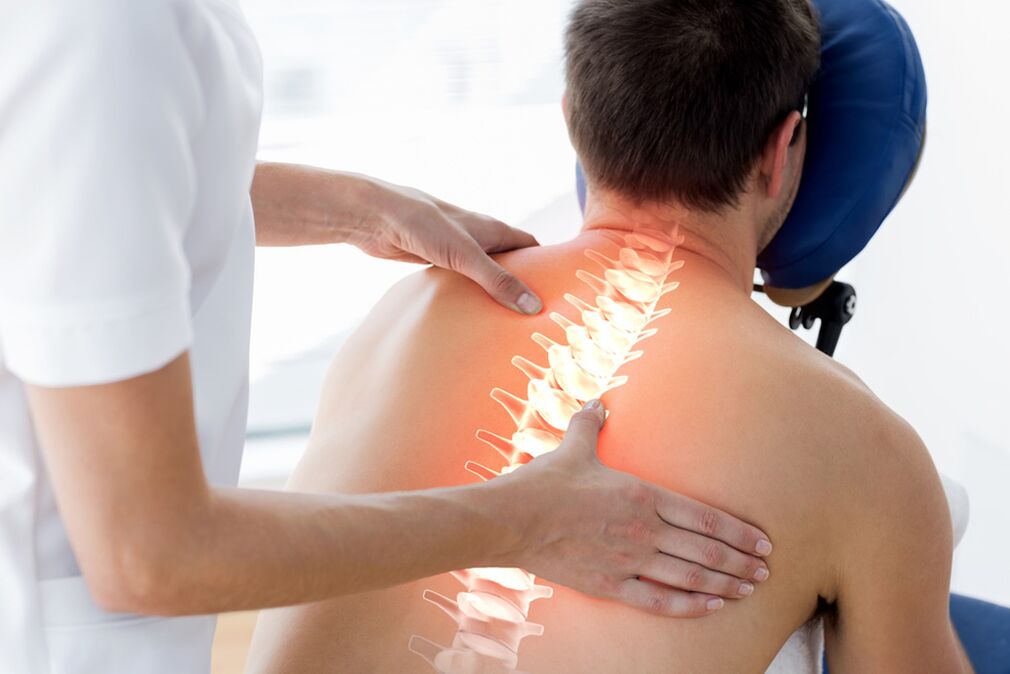Thoracic osteosarcoma occurs with damage to the discs of the thoracic spine. Symptoms of the disease are similar to those of cervical and lumbar pathology. Thoracic osteomas are difficult and often go undiagnosed.

Symptoms of thoracic osteonecrosis in women
This disease is rare in women, because the thoracic spine is less stressed than other parts of the spine. Thoracic spondylolisthesis is difficult to diagnose, as the disease often presents at an advanced stage.
The main symptom of thoracic osteosarcoma in women is pain. Pain can often be localized to the back, sternum, and may also radiate to the upper extremities. In addition, the woman may be tormented by stomach pain. The location of the pain depends primarily on the stage of the disease.
Usually, with osteonecrosis of the thoracic spine, a woman feels constant, non-excruciating pain of a throbbing nature. Signs of thoracic fibrosis also depend on the sensitivity and unique characteristics of a woman's body.
In the beautiful half of humanity, the symptoms of the disease are even more pronounced: the woman's body is more sensitive, and all parts of the spine are thinner than the man's. Degenerative and dystrophic processes in women are more likely to cause negative reactions.
With the beating of the chest part of the ridge, the fair sex has the following symptoms:
- pain when raising your arm or when bending down;
- pain in the mammary glands;
- discomfort in the sternum, aggravated by various loads or prolonged sedentary positions;
- pain when breathing deeply;
- severe pain between the shoulder blades in the flank region;
- feeling of pressure in the chest;
- vascular dystonia.
The above symptoms are provoked by processes occurring in the spine itself. In the case of the formation of a herniated disc, symptoms appear as a result of the development of vascular and neurological pathology.
Manifestations are not less common in women with thoracic osteonecrosis:
- frequent "goose bumps" and numbness in the shoulders and arms;
- feeling hot, cold, or itchy in the lower extremities;
- pain in the area of the heart;
- increased fragility of nails, peeling of the skin;
- functional pathology of the digestive organs: nausea, constipation or diarrhea, abdominal distension.
Because thoracic osteonecrosis occurs with symptoms similar to pneumonia, angina, or cardiac disease, a differential diagnosis should be made. All of the above manifestations suggest the development of thoracic osteonecrosis. However, you should not self-medicate. Only a doctor can make an accurate diagnosis and prescribe an effective treatment.
Symptoms of osteonecrosis of the chest in men
Thoracic osteosarcoma in men is usually diagnosed when the spine is under heavy load (eg, it is often found in builders, loaders, etc. ). The clinical manifestation of osteonecrosis in this case occurs gradually, and at the same time there is a gradual damage to the joints between the ribs and vertebrae. The earlier the disease is diagnosed, the more effective the treatment.
In the early stages, the process of bone degeneration in the chest occurs without any special symptoms, and the man lives without knowing that his disease is progressing. Any discomfort is usually attributed to fatigue that occurs after a long period of work, or an uncomfortable position.
Signs of thoracic osteonecrosis in men in the early stages:
- as a result of compaction of soft tissues, elasticity is reduced in the joint area and a crunching sound occurs between the shoulder blades, the sternum region, the collarbone;
- due to decreased flexibility of the shoulder tendons, difficulty lifting the arm up and putting it behind the back;
- discomfort appears in the affected part of the chest;
- after prolonged physical activity or in a static position, there is a feeling of back fatigue;
- Pain occurs when breathing deeply.
With further progression of the disease, the following symptoms are observed:
- The pain becomes more intense and constant. Due to the constant pressure on the nerve endings, soreness is observed even at rest;
- numbness, tingling in areas of decreased sensitivity;
- there are reflexive periodic contractions of the abdominal muscles, conducted with a feeling of discomfort;
- a man may be tormented by false angina, renal or hepatic colic;
- possible disruption of the pelvic organs, as well as a decrease in potency;
- as a result of osteonecrosis of the rib cage, irritable bowel syndrome develops - a pathology of the functioning of the digestive organs.
Sensory symptoms of coma in thoracic osteonecrosis
The sensation of a coma in the sternum occurs in many patients, but not everyone takes it seriously, because this phenomenon is characterized by a short duration and a very rapid disappearance.
What causes this phenomenon? Most often, the sensation of coma in the sternum occurs due to pathology of the nervous system. However, sometimes the cause of these sensations is necrosis of the rib cage, because in the thoracic region there are large numbers of nerve plexuses.
As a consequence of this pathology, intercostal neuralgia often develops. In this situation, the patient has pressure behind the chest, and the pain is also present, which is more intense when moving the body or when lifting weights. In this case, the pain is similar to pins and needles and is more intense when breathing.
Chest bone tumors often develop due to improper lifestyle, sedentary lifestyle and impaired metabolism. Conservative drug treatment, manual therapy, and lasers come to the rescue. Patients are encouraged to participate in sports or exercise.

























